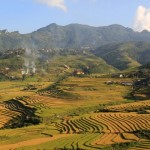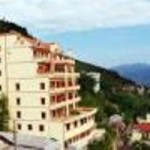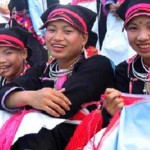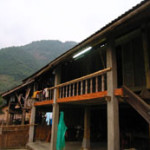What to do in Quan Lan island
Introduction
One of the outlying islands of the Ha Long Bay region and technically in Bai Tu Long bay, Quan Lạn has been sparsely inhabited for quite some time. There are a few thousand residents and an influx of local tourists from Hanoi on weekends and holidays. The island itself is pretty sandy and has little in the way of forest, unlike others nearby such as Ban Sen. Today, ports exist both at the northern and southern tips of the island. It is a less developed and less touristy alternative to the more popular Cat Ba Island.
There are two larger villages on the island with some scattered houses and guesthouses on the roads in between. Minh Chau village is in the north and has a strip of hotels, guesthouses and cabanas along the white sand beach. Quan Lan village is in the center of the island with a street of guesthouses, restaurants, and karaoke venues. The Son Hau beach area has a few resorts and guesthouses near its white sand beach. The beaches of Minh Chau and Son Hau have been claimed to be some of the best in northern Vietnam, if not all of Vietnam, by locals and foreigners alike.
How to get there
Buses leave for the ports in Halong City and Cai Rong from Luong Yen or My Dinh bus stations in Hanoi.
For the Halong City port, catch a bus going to “Hon Gai” which will take about 4 hours. From Hon Gai (Halong City) the ferry leaves at 1 or 1:30 PM and comes back at 6:30 AM (or at 6:15 AM in the summer) and takes around four hours. As of May 2012 the price is 70,000 dong for Vietnamese and 130,000 dong per person for foreigners. This route gives you a scenic boat ride through Bai Tu Long bay and drops you off at the port just south of Quan Lan village.
For the Cai Rong port, catch a bus going to Cua Ong and tell the staff you want to get off at “Cho Cua Ong” (Cua Ong market) and they will drop you off at an intersection in front of taxis that can take you to Cai Rong town about 12 km away. The trip will take 5-6 hours to get to this point. From Cai Rong port there is a ferry at 7 AM (or 6:30 AM in the summer) and 2 PM. Boats from Quan Lan going back to Cai Rong leave at 7 AM (or 6:30 AM in the summer) and 2 PM. The ferry takes two hours. There is a speed boat that makes the trip in 45 minutes that leaves at 7 AM, 8 AM, ! PM and 2 PM from Cai Rong for 140,000 dong per person. Return boats leave around similar times. Private wooden boats can also be chartered for 1,600,000 dong per boat and take around three hours.
Ferry boats will drop you off at the port south of Quan Lan village while private chartered boats can drop people off at the northern port near Minh Chau.
How to get around
Transport is pretty limited: there’s really nothing on the road after sundown. The island is about 15 km and getting around on two wheels on your own is fairly easy.
Hiring a local to drive you somewhere can be an expensive proposition compared to metered taxis elsewhere but you do travel in a xe om (tuk tuk) that is less common to see in bigger cities in Vietnam. Prices are given per vehicle so it is cheaper if you travel with groups. A ride to get half way up the island costs foreigners 100,000 – 150,000 dong. From Minh Chau port or beach to Quan Lan village, almost the entire way across the island, is 250,000 dong. It is best to organize early morning rides to the port with a guesthouse or hotel the evening before. There are a few buses that cost 10,000 dong that only run on weekends.
Bicycles can be rented from hotels or guesthouses for 50,000 – 70,000 dong of varying quality. Motorbikes can be rented for 100,000 – 150,000 dong. Petrol can be found at the corner stores at the intersection in Quan Lan village for around 40,000 – 50,000 dong. Look for the large water bottles full of Ecto Cooler looking neon green liquid. The roads are generally in decent condition but still have potholes, are often covered in sand, and have construction cars careening across them. There would appear to be little vehicle crime as locks are not given with rentals.
What to see
Half-way down the island, the western side features an industrial port at the tip of a very long breakwater that dissects an expansive tidal mangrove flat.
On the eastern side of the island directly east of the breakwater is a fantastic beach, which can be reached either by trudging across undeveloped dunes and tidal waters, or heading south slightly then following the road down to the single building on the beach, billing itself as a hotel.
There are a few temples scattered across the island.
What to do
Walk about and explore, or swim. Don’t expect much except scenery, and you’ll have a good time.
Visit Minh Chau (northern) or Son Hau (central/eastern) beaches with beautiful water and soft white sand. Minh Chau beach has cabanas lining the beach with rentable hammocks, loungers, and chairs. There are inner tubes and volleyball nets for rent as well.
Where to eat
Food can be more expensive than the mainland. The cheapest food is generally found in smaller family run guesthouses. During the week food can be hard to come by and visitors should get used to variations of things made with instant ramen noodles. Staying at resorts and guesthouses out of town usually involves informing the staff of future meals and some heavy bargaining and negotiation for high prices.
Food in Quan Lan village can be found for around 25,000 – 50,000 dong for a noodle, rice noodle or congee (rice soup) dish. Rice and noodle dishes later in the day can be found for 25,000 – 80,000 dong. Seafood dishes abound in town and can be found for a wide range of 60,000 – 150,000 dong.
Food in Minh Chau is more expensive and can get into the 100,000 – 200,000 dong range. There is western, particularly French, food available at Le Pont hotel.
Coffee is the strong and bitter Vietnamese variety served black or with condensed milk and can be found for 15,000 – 40,000 dong. Beer can be found at places labeled “Bia Hoi” for around 10,000 dong for draft beers and 15,000 – 30,000 for cold cans. Cold drinks are hard to find as electricity is not constant. Ice cream in smaller stores have the consistency of melted and refrozen treats.
Most menus do not have prices and it would be wise to ask before ordering. Vietnamese menus are generally more extensive than the one to two page English menus. Wandering around town at off hours may also mean that staff are napping or off site and inquiring with neighbors is the fastest way to see if anything is available.
Where to stay
Prices are higher during weekends and holidays as many people go to Quan Lan Island as a weekend trip from Hanoi. The prices during high season (mid April – mid September) can be as high as double low season rates. The accommodation in Minh Chau and Son Hau tend to be more expensive as they are walkable to the nicer beaches. The lodging and food is generally cheaper in Quan Lan village. Not much English is spoken although most people are happy to write down prices for you on paper or using their cell phone. Electricity is only on from 10 AM – 2 PM and 6 PM – 11 PM by generator with some of the larger hotels and resorts having their own personal generators but controlling the hours air conditioning can be used.
Quan Lan village
During high season during the week on Dong Nam street (the main and really only street) in Quan Lan village, rooms with two double beds can be found with fan for 200,000 – 300,000 dong at most of the family run and some of the larger guesthouses and hotels.
Tuan Thuy, ☎ 0333 877 329. Close to the big intersection in town with cheap, delicious food and coffee available in the restaurant downstairs. Cheap motorbikes and bicycles are available for rent. Little to no English spoken but a limited English menu is available. Fan room: 200,000 dong.
Minh Vu Guesthouse, ☎ (+84)33 877 479. One of the oldest guesthouses in Quan Lan village that can be found on the east side of Dong Nam street on a corner leading out of town. High season room on a weekday with fan: 200,000 dong.
ANN Hotel, ☎ (+84)33 877 889 (sales@annhotel.com.vn). Clean, new looking hotel on the main road in Quan Lan village with a pleasant patio area for their restaurant. Food is slightly pricier than other places in town but appears to be fresher as shipments arrive daily and cold drinks are always available. The hotel does have its own private generator that is not always on. The staff speak some English, the most of any guest house in this village. The karaoke venue on the top floor appears to be quite popular and loud but usually stops when the town electricity goes out at 11 PM. Wifi is available in the lobby and restaurant. Motorbikes and bicycles are available for rent. High season on a weekday: two double beds with fan: 300,000 dong with a/c: 450,000 dong.
Song Chau Villa, ☎ 0333 877 566 (songchauvilla@gmail.com). Villa on the outside of Quan Lan village. Two person high season room: 450,000 dong. Low season: 250,000 dong.
Son Hau village
Van Hai Resort. Right on Son Hau beach with various types of standalone villas and bungalows along the sand. 1,600,000 dong to 2,500,000 dong.
Hung Lam Resort, ☎ (+84)333877888 (info@hunglamecotourism.vn). Two star resort a short walk from Son Hau beach with a restaurant, air conditioning and pier transfer. 600,000 dong to 1,600,000 dong.
Minh Chau village
Binh Minh Guesthouse. On a corner on the edge of Minh Chau village still walkable to Minh Chau beach. 400,000 dong on high season weekends.
Hoy Huang Guesthouse. Relatively new and large hotel with an on premise restaurant with a large menu. Food is in the over 100,000 dong range for most dishes. High season: 500,000 dong.
Minh Chau Resort, ☎ 0919 091 468 (minhchauresort@gmail.com). Resort near the beautiful Minh Chau beach on the north end of the island. Air-conditioning is available from 13:00 pm to 15:30pm and from 21:30pm to 6:00am. Weekdays: 1,500,000 dong to 1,900,000 dong. Weekends: 1,800,000 dong to 2,200,000 dong. Holidays: 2,200,000 dong to 2,600,000 dong.
Shopping
There are currently no ATMs on the island. A few small shops scattered in the villages carry the straw, coolie and safari hats you can see locals wearing as well as some clothing. There is a fish market at 5:30 – 6:30 and 2:30 – 3:30.








